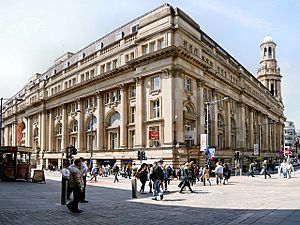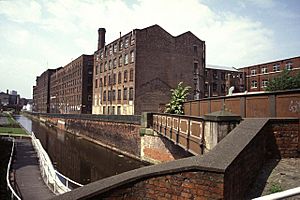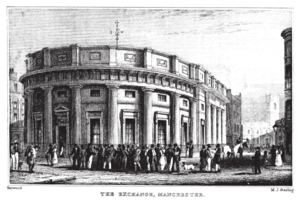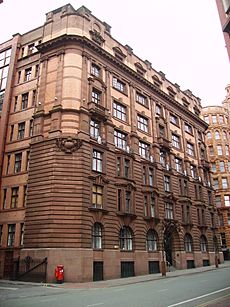Cottonopolis facts for kids
Cottonopolis was a special nickname given to Manchester in the 1800s. It meant "Cotton City" because Manchester was a huge and important city (a metropolis) that became the world's main hub for making cotton.
Contents
How Manchester Became Cottonopolis
In the early days, cotton factories (called mills) used water power. They were built in Lancashire and nearby areas. In 1781, Richard Arkwright opened the first steam-powered textile mill in Manchester. This was a big step!
Steam power helped factories make things much faster. This led to mass production, where huge amounts of goods are made. As cotton making moved from homes to factories, Manchester and nearby towns became the biggest cotton spinning center in the world. By 1871, they used 32% of all the cotton made globally!
Ancoats, a part of Manchester, became the first industrial suburb. It was full of steam-powered mills. Some of these mills were built with new ideas, like using iron and concrete to prevent fires.
Growth of Cotton Mills
In 1853, Manchester had 108 cotton mills, which was the most ever. After that, more mills started opening in towns around Manchester. Towns like Bury, Oldham, Rochdale, Bolton, and Blackburn became very important for cotton. Oldham even became the world's top cotton spinning town at one point!
As cotton making spread to other towns, Manchester became the main business center. It had warehouses, banks, and services for about 280 cotton towns and villages nearby. The name "Cottonopolis" became popular around 1870.
Connecting the Cotton World
Manchester also became a key transport hub. The Bridgewater Canal helped move goods easily. Raw cotton arrived from places like the West Indies, the southern United States, and India. Coal from Worsley was also brought in by canal.
In 1830, the Liverpool and Manchester Railway opened. It built a warehouse at its Manchester station. This railway network helped connect Manchester to its growing industrial areas. By the late 1800s, Lancashire had four million people. More than a quarter of them worked in industries, mostly making textiles.
The Cotton Exchange
The heart of business in Cottonopolis was the trading hall of the Cotton Exchange. The first exchange in Manchester was built in 1727 for traders to do business. It was rebuilt several times.
A new exchange, designed by Thomas Harrison, opened in 1809. To trade there, you had to be a member. At first, mill and warehouse owners traded, but later their agents and managers did the business.
In 1851, Queen Victoria visited and gave it the name "Manchester Royal Exchange." The Royal Exchange was rebuilt again in 1874 and then lavishly updated between 1914 and 1921. At that time, it had the largest trading room in the world!
Its huge hall was almost 30 meters high. Up to 11,000 cotton merchants would meet there every Tuesday and Friday. They traded their goods under a large glass dome. The Royal Exchange was badly damaged in World War II. It stopped being used for cotton trading in 1968.
Warehouses: Storage and Showrooms
In the second half of the 1800s, Manchester became famous for its many warehouses. In 1806, there were just over 1,000 warehouses. By 1815, this number had almost doubled to 1,819! Manchester was even called "warehouse city."
The first warehouses were built around King Street. Later, they spread to Portland Street and Whitworth Street. Famous warehouses like Watts Warehouse were built in a grand style.
In 1844, a writer named Johann Georg Kohl described Manchester's streets. He wrote about the "great warehouses, five or six stories high, all large and imposing." He said they were "brilliantly lighted from top to bottom" at night.
Huge packing warehouses like Asia House, India House, and Velvet House on Whitworth Street were some of the tallest buildings of their time. These impressive buildings were like the grand homes of the cotton industry. They not only stored goods but also showed off the finished products.
Banking in Cottonopolis
By the late 1820s, Manchester was growing into an important city. New laws helped it become more independent. For example, in 1838, Manchester became a municipal borough, meaning it could elect its own local government.
As the cotton industry grew, huge amounts of money moved through Manchester. This led to many new banks and financial services opening.
In 1772, Arthur Heywood's Bank opened in Manchester. But money had to be sent to London banks every day by horse-drawn coach. These coaches were often attacked by highwaymen!
The first bank in Manchester to keep its own money was the Bank of Manchester, which opened in 1829. Many other banks followed, especially around Spring Gardens, Fountain Street, and King Street. This area became the main business and banking center of the city.
Cottonopolis Today
Many of the old cotton mills, canals, and bridges from the 1700s and 1800s are still around today. The area known as "warehouse city" is considered one of the best examples of a Victorian business center in the United Kingdom.
This area is even part of Manchester and Salford's bid to become a World Heritage Site by UNESCO.
The Royal Exchange building was fixed up in 1972. It became home to a very famous theater, one of the best outside London. In 1996, the Royal Exchange was damaged by a bomb. It was rebuilt at a cost of £32 million.
See also
- Manchester cotton warehouses
- Textile manufacture during the Industrial Revolution
- Linenopolis






